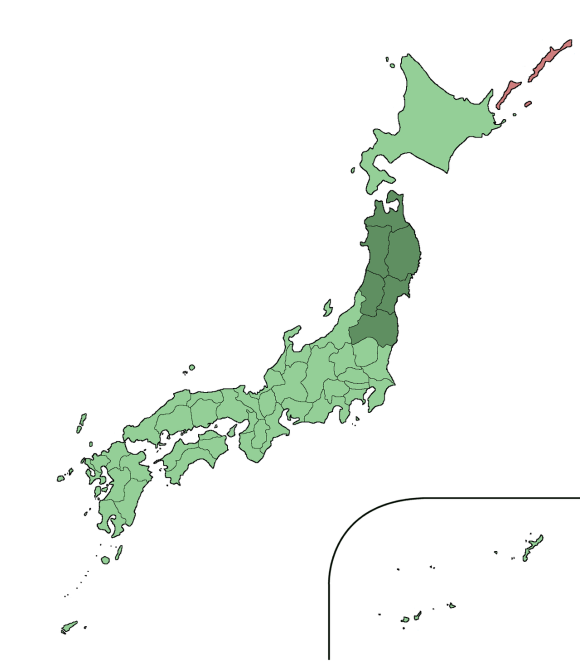Videos reveal the eerie scenes and sirens that residents woke up to in the northern part of the country this morning.
Earlier this year, escalating tensions between North Korea and the United States prompted renewed interest in Japan’s J-Alert warning system, a government-created information network designed to transmit information to residents via email, outdoor speakers and administrative municipalities in the event of a security threat to the country.
This morning, the warning system was activated in the northern part of Japan, after North Korea fired three missiles over the country at 5:58 a.m. The missiles, which fell into the Pacific Ocean approximately 1,180 kilometres (733 miles) east of Cape Erimo on Japan’s northernmost island of Hokkaido at 6:12 a.m., followed a trajectory over the heavily populated Tohoku region.
▼ Cape Erimo in Hokkaido
As the Japanese government confirmed the trajectory of the missiles, the J-Alert system was promptly initiated in the prefectures of Tohoku and its surrounding areas of Hokkaido, Aomori, Iwate, Miyagi, Akita, Yamagata, Fukushima, Ibaraki, Tochigi, Gunma, Niigata, and Nagano.
▼ Japan’s Tohoku region, pictured in dark green below
The J-Alert system is used when North Korea launches its ballistic missiles, in order to provide information about the launches and their trajectories via email to those registered to receive the J-Alert via one of the country’s many disaster prevention information apps.
In the event of a much more imminent threat to Japanese soil, a “national protection siren” will sound as part of more drastic measures to safeguard residents, and this is the siren that many residents woke up to this morning.
▼ The J-Alert website states that this siren will sound to alert residents of an approaching missile.
▼ This video shows the siren as it sounded this morning in Nagano Prefecture.
Accompanying the siren was this announcement from local governments, which was relayed via loudspeakers: “A missile has been fired from the West Coast of North Korea in the direction of the Tohoku region. Please take refuge in a solid building or below ground.”
▼ This tweet reveals the announcement that sounded in the area below the missile’s trajectory.
https://twitter.com/jtnarsico/status/902282149486665728Given that Japanese residents are used to hearing announcements and test sirens relayed from city hall via loudspeakers, some people wondered if the missile launch had really happened or if it was a test announcement.
Well that was a frightening way to wake up. #northkorea #missile pic.twitter.com/zta3roNtyg
— Skellis (@Skellis13) August 28, 2017
This wasn’t a test, as the warning system was delivered via mobile apps as well, relaying the same message to residents on their mobile phones.
https://twitter.com/jtnarsico/status/902283845986168832While the world waits to find out what the next step will be in the ever-escalating tensions between North Korea and the United States and its allies, people in Japan are relying on the J-Alert system to help them prepare for imminent attacks.
To find out more about J-Alert system and what to do in the event of a military emergency while in Japan, visit the Cabinet Secretariat Civil Protection Portal Site for more information.
Source: Net Lab
Featured image: Twitter/@jtnarsico
Insert image: Wikipedia/Ningyou


 North Korea-U.S. tensions spark interest in Japanese government’s J-Alert warning system
North Korea-U.S. tensions spark interest in Japanese government’s J-Alert warning system North Korea fires new missile over Japan, residents woken by government warning systems
North Korea fires new missile over Japan, residents woken by government warning systems North Korea missile alert manga produced by Japanese government office
North Korea missile alert manga produced by Japanese government office North Korea has developed nuclear-capable missiles capable of hitting the US
North Korea has developed nuclear-capable missiles capable of hitting the US 8 ways Kim Jong-Un has blindsided the US
8 ways Kim Jong-Un has blindsided the US Red light district sushi restaurant in Tokyo shows us just how wrong we were about it
Red light district sushi restaurant in Tokyo shows us just how wrong we were about it Historical figures get manga makeovers from artists of Spy x Family, My Hero Academia and more
Historical figures get manga makeovers from artists of Spy x Family, My Hero Academia and more Japan’s massive matcha parfait weighs 6 kilos, contains hidden surprises for anyone who eats it
Japan’s massive matcha parfait weighs 6 kilos, contains hidden surprises for anyone who eats it Haku is…Chihiro’s dead brother? Studio Ghibli fans blown away by Spirited Away theory
Haku is…Chihiro’s dead brother? Studio Ghibli fans blown away by Spirited Away theory Sandwiches fit for a sumo served up in Osaka【Taste Test】
Sandwiches fit for a sumo served up in Osaka【Taste Test】 Beautiful Red and Blue Star luxury trains set to be Japan’s new Hokkaido travel stars
Beautiful Red and Blue Star luxury trains set to be Japan’s new Hokkaido travel stars Pokémon Sleep camping suite and guestrooms coming to Tokyo Hyatt along with giant Snorlax burgers
Pokémon Sleep camping suite and guestrooms coming to Tokyo Hyatt along with giant Snorlax burgers Japan’s cooling body wipe sheets want to help you beat the heat, but which work and which don’t?
Japan’s cooling body wipe sheets want to help you beat the heat, but which work and which don’t? Tokyo Tsukiji fish market site to be redeveloped with 50,000-seat stadium, hotel, shopping center
Tokyo Tsukiji fish market site to be redeveloped with 50,000-seat stadium, hotel, shopping center Starbucks Japan adds a Motto Frappuccino to the menu for a limited time
Starbucks Japan adds a Motto Frappuccino to the menu for a limited time McDonald’s new Happy Meals offer up cute and practical Sanrio lifestyle goods
McDonald’s new Happy Meals offer up cute and practical Sanrio lifestyle goods All-you-can-drink Starbucks and amazing views part of Tokyo’s new 170 meter-high sky lounge
All-you-can-drink Starbucks and amazing views part of Tokyo’s new 170 meter-high sky lounge More foreign tourists than ever before in history visited Japan last month
More foreign tourists than ever before in history visited Japan last month Japanese ramen restaurants under pressure from new yen banknotes
Japanese ramen restaurants under pressure from new yen banknotes French Fries Bread in Tokyo’s Shibuya becomes a hit on social media
French Fries Bread in Tokyo’s Shibuya becomes a hit on social media Studio Ghibli releases new action figures featuring Nausicaä of the Valley of the Wind characters
Studio Ghibli releases new action figures featuring Nausicaä of the Valley of the Wind characters New private rooms on Tokaido Shinkansen change the way we travel from Tokyo to Kyoto
New private rooms on Tokaido Shinkansen change the way we travel from Tokyo to Kyoto Starbucks reopens at Shibuya Scramble Crossing with new look and design concept
Starbucks reopens at Shibuya Scramble Crossing with new look and design concept Studio Ghibli glasses cases let anime characters keep an eye on your spectacles
Studio Ghibli glasses cases let anime characters keep an eye on your spectacles Beautiful Ghibli sealing wax kits let you create accessories and elegant letter decorations【Pics】
Beautiful Ghibli sealing wax kits let you create accessories and elegant letter decorations【Pics】 Studio Ghibli releases Kiki’s Delivery Service chocolate cake pouches in Japan
Studio Ghibli releases Kiki’s Delivery Service chocolate cake pouches in Japan New definition of “Japanese whiskey” goes into effect to prevent fakes from fooling overseas buyers
New definition of “Japanese whiskey” goes into effect to prevent fakes from fooling overseas buyers Our Japanese reporter visits Costco in the U.S., finds super American and very Japanese things
Our Japanese reporter visits Costco in the U.S., finds super American and very Japanese things Studio Ghibli unveils Mother’s Day gift set that captures the love in My Neighbour Totoro
Studio Ghibli unveils Mother’s Day gift set that captures the love in My Neighbour Totoro New Japanese KitKat flavour stars Sanrio characters, including Hello Kitty
New Japanese KitKat flavour stars Sanrio characters, including Hello Kitty New Pokémon cakes let you eat your way through Pikachu and all the Eevee evolutions
New Pokémon cakes let you eat your way through Pikachu and all the Eevee evolutions Disney princesses get official manga makeovers for Manga Princess Cafe opening in Tokyo
Disney princesses get official manga makeovers for Manga Princess Cafe opening in Tokyo Sales of Japan’s most convenient train ticket/shopping payment cards suspended indefinitely
Sales of Japan’s most convenient train ticket/shopping payment cards suspended indefinitely Sold-out Studio Ghibli desktop humidifiers are back so Totoro can help you through the dry season
Sold-out Studio Ghibli desktop humidifiers are back so Totoro can help you through the dry season Japanese government to make first change to romanization spelling rules since the 1950s
Japanese government to make first change to romanization spelling rules since the 1950s Ghibli founders Toshio Suzuki and Hayao Miyazaki contribute to Japanese whisky Totoro label design
Ghibli founders Toshio Suzuki and Hayao Miyazaki contribute to Japanese whisky Totoro label design Doraemon found buried at sea as scene from 1993 anime becomes real life【Photos】
Doraemon found buried at sea as scene from 1993 anime becomes real life【Photos】 Tokyo’s most famous Starbucks is closed
Tokyo’s most famous Starbucks is closed One Piece characters’ nationalities revealed, but fans have mixed opinions
One Piece characters’ nationalities revealed, but fans have mixed opinions We asked a Uniqlo employee what four things we should buy and their suggestions didn’t disappoint
We asked a Uniqlo employee what four things we should buy and their suggestions didn’t disappoint Princesses, fruits, and blacksmiths: Study reveals the 30 most unusual family names in Japan
Princesses, fruits, and blacksmiths: Study reveals the 30 most unusual family names in Japan Close call – Passenger plane passed through North Korean missile trajectory just 6 minutes later
Close call – Passenger plane passed through North Korean missile trajectory just 6 minutes later Here’s the military exercise that has North Korea freaking out
Here’s the military exercise that has North Korea freaking out Hackers to Gundam: 5 rumors about failed North Korean missile launch surface on Japanese Internet
Hackers to Gundam: 5 rumors about failed North Korean missile launch surface on Japanese Internet Japan’s kanji character of the year for 2017 is “north”
Japan’s kanji character of the year for 2017 is “north” The power of fast food: Supreme Leader Kim Jong-un wants McDonald’s to invest in North Korea
The power of fast food: Supreme Leader Kim Jong-un wants McDonald’s to invest in North Korea Selfie love shown between South and North Korean gymnasts
Selfie love shown between South and North Korean gymnasts America admits it has no idea what Kim Jong-un is doing
America admits it has no idea what Kim Jong-un is doing Typhoon alert goes off on train commuters’ phones, tourists mistake it for Godzilla attack
Typhoon alert goes off on train commuters’ phones, tourists mistake it for Godzilla attack North Korea launches missiles into Japan Sea because it’s just that time again
North Korea launches missiles into Japan Sea because it’s just that time again Wait, did North Korea really just call South Korea’s president a “blabbering peasant woman”?
Wait, did North Korea really just call South Korea’s president a “blabbering peasant woman”? The latest spat between the two Koreas took a really bizarre turn
The latest spat between the two Koreas took a really bizarre turn Kim Jong-un’s “little red book” of quotes is the worst joke book you can buy for 500 yen
Kim Jong-un’s “little red book” of quotes is the worst joke book you can buy for 500 yen North Korea claims successful hydrogen bomb test, world very skeptical
North Korea claims successful hydrogen bomb test, world very skeptical Is North Korea really forcing its young men to get Kim Jong-un’s haircut? Probably not…
Is North Korea really forcing its young men to get Kim Jong-un’s haircut? Probably not… Massive storm lights up Tokyo with thousands of lightning strikes 【Pics & Videos】
Massive storm lights up Tokyo with thousands of lightning strikes 【Pics & Videos】
Leave a Reply